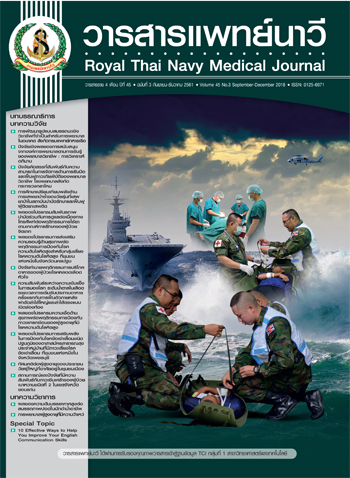Selected Variables Related to Disaster Response and Recovery Management Abilities of Professional Nurse Hospital under the Ministry of Defense
Main Article Content
Abstract
The purposes of this descriptive research were to explore the disaster response and recovery management bilities, and to examine the relationships between division, training, disaster operation time, staff mpowerment of leader, teamwork, and disaster response and recovery management abilities of professional nurses, hospitals under the Ministry of defense. The populations were 268 professional nurses, hospitals nder the Ministry of defense. The research instruments were personal factor, staff empowerment of leader, teamwork, and disaster response and recovery management abilities questionnaires which were confirmed content validity by experts and were tested for content validity and reliability. Cronbach’s alpha coefficients was .96 of staff empowerment, .96 of teamwork and .96 of disaster response and recovery management bilities. Data were analyzed by frequency, percentage, mean, standard deviation, chi-square test and earson’s product moment correlation coefficient. The major findings were as follow: 1. Disaster response and recovery management abilities of professional nurses hospitals under the Ministry of defense was the high level ( = 3.64, SD = 0.65 ) 2) There was significant relationship between training and disaster response and recovery management abilities of professional nurses, hospitals under the Ministry of defense at the .05 level (c2 = 9.821, C = .188) There was positively significant relationship between staff empowerment of leader, teamwork, and disaster response and recovery management abilities of professional nurses, hospitals under the Ministry of defense at the .05 level (r = .557 and .838 respectively). Personal factor consisting of division and disaster operation time was not significant related to the disaster response and recovery management abilities of professional nurse hospital under the Ministry of defense.
Article Details

This work is licensed under a Creative Commons Attribution-NonCommercial-NoDerivatives 4.0 International License.
References
WHO. Medium-term strategic plan 2009-2013. [Internet]. [cited 2017 June 1]. Available from: https://apps.who.int/gb/ebwha/pdf_files/MTSP2009/MTSP1-en.pdf.
California Medical Services Authority (CMSA). Introduction to community paramedicine. [Internet]. [cited 2017 June 1]. Available from: https://emsa.ca.gov/community_paramedicine/
Siripukdeekan A, Wiserith W. A study of disaster nursing management. Journal of The Royal Thai Army Nurses 2014;15(2):348-59. (in Thai).
Thanaroj S, Sadhittwithayanan S, Chantra R. Nurse competencies in disaster management. Journal of Boromarajonani College of Nursing, Bangkok 2014;30(3):35-44. (in Thai).
Ning N, Kang Z, Jiao M, Hao Y, Gao L, Sun H, et al. Factors affecting emergency preparedness competency of public health inspectors: a cross-sectional study in northeastern China. [Internet]. [cited 2017 June 1]. Available from: https://bmjopen.bmj.com/content/4/1/e003832.
Laschinger HK, Finegan J. Empowering nurses for work engagement and health in hospital settings. Journal of Nursing Administration 2005;35:439–49.
Gibson JL, Ivancevich JM, Donnelly JH. Organization: behavior, structure, processes. 12th ed. Boston: McGrew-Hill/Irwin; 1991.
Klein C, DiazGranados D, Salas E, Le H, Burke CS, Lyons R, et al. Does team building work? Small Group Res 2009;40(2):181–222.
International Council of Nursing. ICN Framework of disaster nursing competencies 2009: World Health Organization. [Internet]. [cited 2016 March 1]. Available from: https://icn.ch.
Kanter RM. Rosabeth Moss Kanter on the frontiers of management. Boston, Mass: Harvard Business School Press; 1997.
McCloskey DN. The rhetoric of economics. 2nd ed. Madison: University of Wisconsin Press;1998.
Komtae S, Prachusilpa G. Competency of hyperbaric nurse. Royal Thai Navy Medical Journal 2018;45(1):39-51. (in Thai).
กรมแพทย์ทหารเรือ. แผนปฏิบัติการด้านการแพทย์สนับสนุนการบรรเทาสาธารณภัย ทร. [อินเทอร์เน็ต]. [เข้าถึงเมื่อ 1 มิถุนายน 2556]. แหล่งที่มา: https://www.nmd.go.th/person/file.php/1/k4.pdf.
Phokhang-Just W, Sarakshetrin A, Chantra R. Knowledge, attitude, and practice towards nutrition and nutrition lebels of nursing students at Boromarajonani College of Nursing, Surat-Thani. Journal of The Royal Thai Army Nurses
;16(1):93-100. (in Thai).
Shih FJ, Liao YC, Chan SM, Duh BR, Gau ML. The impact of the 9-21 earthquake experiences of Taiwanese nurses as rescuers. Soc Sci Med 2002;55(4):659-72.
Khunpech A, Hirunchunha S, Naka K. Competency responding to public hazardous events perceived by community hospital. [Internet]. [cited 2016 September 1]. Available from: https://www.taem.or.th/node/131.
Phakdeechanuan K, Songwathana P, Sae-Sia W. Thai nurses’ learning need regarding disaster nursing: high needs? NMJN 2015;5(2):56-66.
Jiang L, He HG, Zhou WG, Shi SH, Yin TT, Kong Y. Knowledge, attitudes and competence in nursing practice of typhoon disaster relief work among Chinese nurses: a questionnaire survey. Int J Nurs Pract 2016;21(1):56-72.
Ketanun C, Prachusilpa G. Predicting factors of competency of hemodialysis nurse. Journal of The Police Nurse 2014;6(1):71-87. (in Thai).


